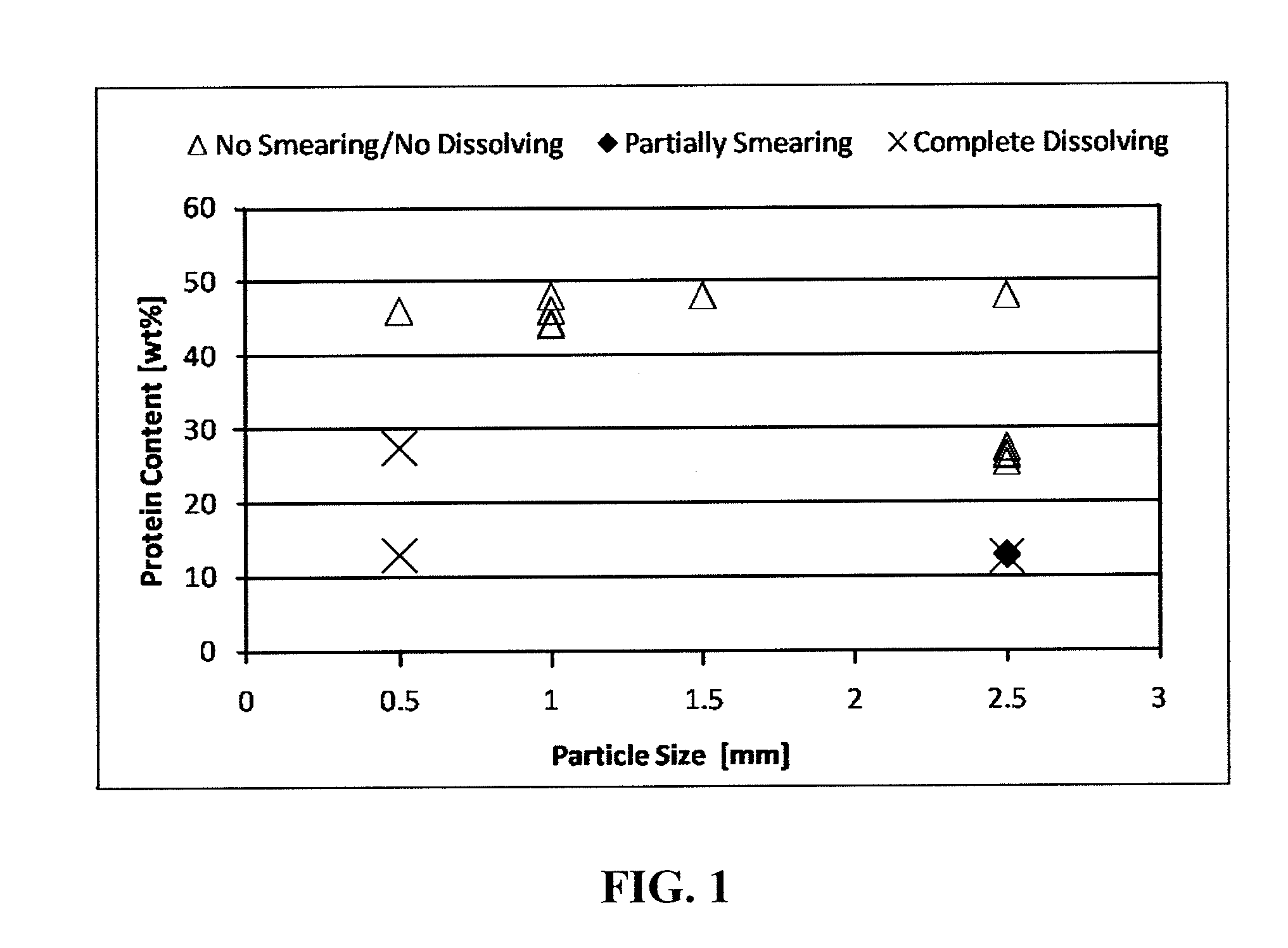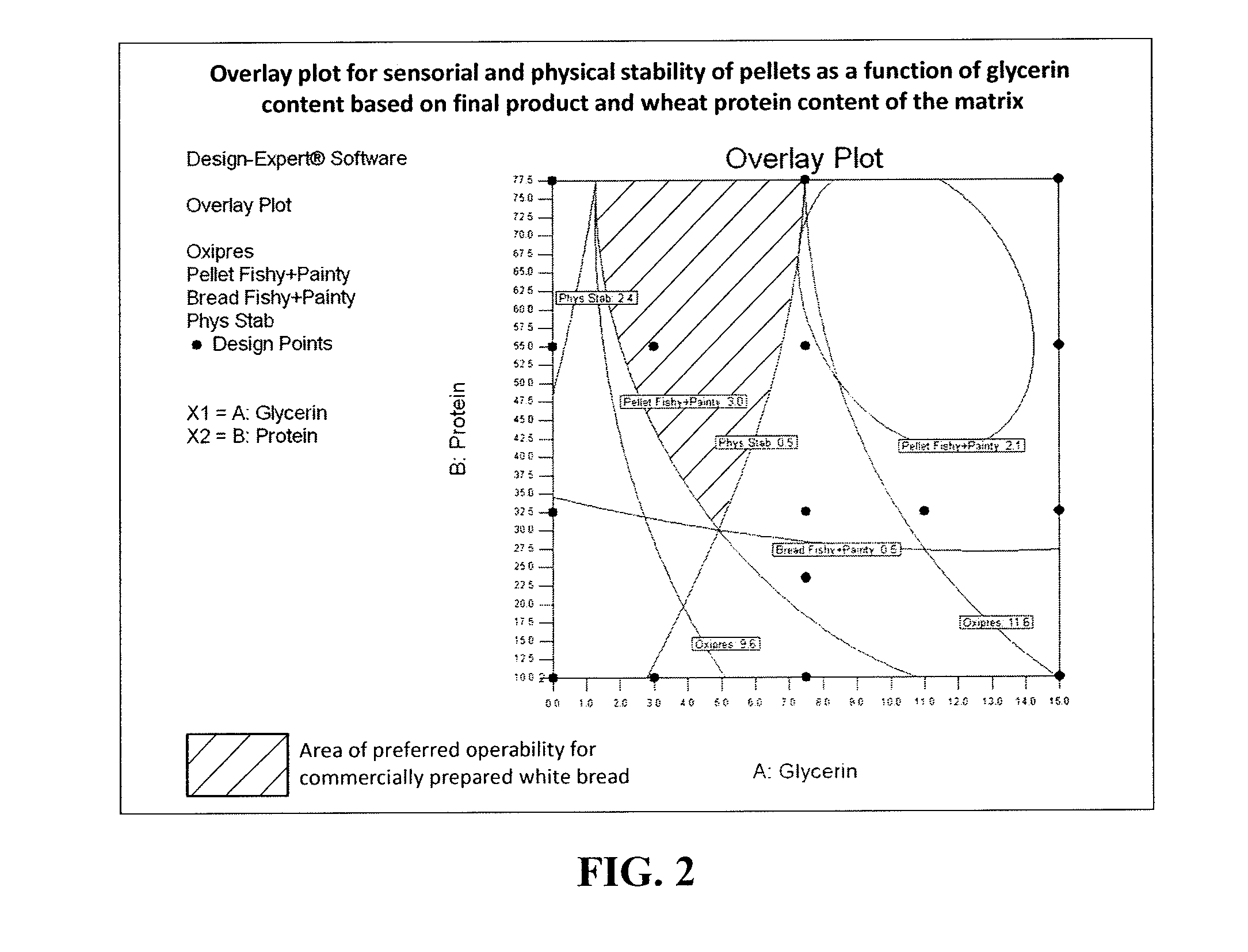Encapsulated omega-3 fatty acids for baked goods production
a technology of encapsulated omega-3 fatty acids and baked goods, which is applied in the field of baked goods, can solve the problems of pufa compounds' high unsaturation, the inability to realize the nutritional benefits of pufa compounds, and the subsequent deterioration of the flavor and aroma of the oil, so as to avoid rubbery consistency and texture, prevent substantial smearing and dissolution of the encapsulated product, and harden the encapsulated product
- Summary
- Abstract
- Description
- Claims
- Application Information
AI Technical Summary
Benefits of technology
Problems solved by technology
Method used
Image
Examples
example 1
[0088]This Example demonstrates the production of encapsulated products containing polyunsaturated fatty acids (algae oil), and the effect of matrix material protein content, protein content of the encapsulated product, and pellet size on the physical survival of the encapsulated products in bread. The Example also demonstrates the stabilizing effect of an acidic antioxidant (ascorbic acid) on omega-3 oils incorporated in the encapsulated products in bread. The ingredients and their relative amounts which may be used to produce the encapsulated products are shown in Table 1:
TABLE 1Product formulas of variations bread-1 through bread-19 expressed aswt % as is after extrusion / anticaking processing:Ingredients(% moisture / % protein)1%2%3%4%5%6%7%8%9%Durum Flour (12 / 15)59.357.659.760.830.646.646.646.646.3Wheat Protein (3 / 100)0.00.00.00.030.611.711.711.611.6Algae Oil (0 / 0)9.79.19.49.810.19.49.49.79.7Ca-Carbonate (0.2 / 0)5.45.13.43.43.45.45.45.45.4Corn Starch (13 / 0)5.45.13.43.43.45.45.45.45...
example 2
[0095]This Example demonstrates the production of encapsulated products containing polyunsaturated fatty acids (algae oil) and the use of the encapsulated products in a commercial white bread application. The Example shows the effect of matrix material protein content, protein content of the encapsulated product, and glycerin content of the encapsulated product on the sensorial and oxidative stability of the encapsulated product, the physical survival of the encapsulated products in commercial style bread, and the sensorial stability of bread fortified with the encapsulated product.
Production of Encapsulated Products
[0096]The ingredients and their relative amounts which may be used to produce the encapsulated products are shown in Table 5:
TABLE 5Product formulas of variations 1 through 17 expressed as wt % as is afterextrusion / anticaking processing:Ingredients(% moisture / % protein)1%2%3%4%5%6%7%8%9%Durum Flour (12 / 10)56.753.049.041.538.935.927.026.325.3Wheat Protein (3 / 100)0.00.00.0...
PUM
| Property | Measurement | Unit |
|---|---|---|
| diameter | aaaaa | aaaaa |
| diameter | aaaaa | aaaaa |
| temperature | aaaaa | aaaaa |
Abstract
Description
Claims
Application Information
 Login to View More
Login to View More - R&D
- Intellectual Property
- Life Sciences
- Materials
- Tech Scout
- Unparalleled Data Quality
- Higher Quality Content
- 60% Fewer Hallucinations
Browse by: Latest US Patents, China's latest patents, Technical Efficacy Thesaurus, Application Domain, Technology Topic, Popular Technical Reports.
© 2025 PatSnap. All rights reserved.Legal|Privacy policy|Modern Slavery Act Transparency Statement|Sitemap|About US| Contact US: help@patsnap.com


